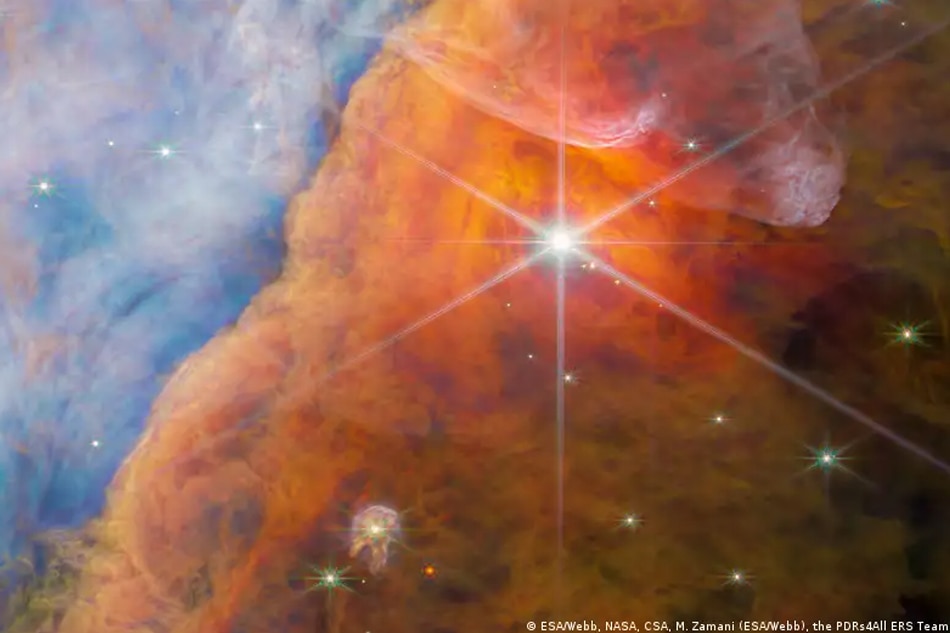Why detecting carbon molecules in space matters
ADVERTISEMENT

Welcome, Kapamilya! We use cookies to improve your browsing experience. Continuing to use this site means you agree to our use of cookies. Tell me more!
Why detecting carbon molecules in space matters
Deutsche Welle
Published Jul 04, 2023 02:15 AM PHT
One of the most important unsolved problems of modern science is: How did life arise from non-living matter?
One of the most important unsolved problems of modern science is: How did life arise from non-living matter?
We still don't know but we have a good idea of what the required steps are, for instance, the formation of complex organic molecules, like amino acids, from simpler ones, like CH3+, or methylium.
We still don't know but we have a good idea of what the required steps are, for instance, the formation of complex organic molecules, like amino acids, from simpler ones, like CH3+, or methylium.
LIFE AS WE KNOW IT IS CARBON-BASED
The CH3+ molecule, which is also known as methyl cation, has been detected in space for the first time by the James Webb Space Telescope (JWST). The preliminary unedited results were published on June 26, 2023, in the journal Nature.
The CH3+ molecule, which is also known as methyl cation, has been detected in space for the first time by the James Webb Space Telescope (JWST). The preliminary unedited results were published on June 26, 2023, in the journal Nature.
Organic molecules are carbon-based. They contain carbon atoms bonded to hydrogen atoms but can also bond to other elements, such as oxygen, nitrogen, or phosphorus.
Organic molecules are carbon-based. They contain carbon atoms bonded to hydrogen atoms but can also bond to other elements, such as oxygen, nitrogen, or phosphorus.
ADVERTISEMENT
Everything that makes us and all life on Earth is carbon-based.
Everything that makes us and all life on Earth is carbon-based.
CH3+ is a very simple organic molecule, with just one carbon atom and 3 hydrogen atoms. But it reacts with other molecules to form more complex ones. Its presence in space tells us that basic building blocks for life are out there.
CH3+ is a very simple organic molecule, with just one carbon atom and 3 hydrogen atoms. But it reacts with other molecules to form more complex ones. Its presence in space tells us that basic building blocks for life are out there.
"This CH3+ is an initiator of a lot of very interesting more complex reactions," said Stephan Schlemmer, a professor of experimental physics at Cologne University in Germany. Schlemmer was part of an international team that worked on the latest findings.
"This CH3+ is an initiator of a lot of very interesting more complex reactions," said Stephan Schlemmer, a professor of experimental physics at Cologne University in Germany. Schlemmer was part of an international team that worked on the latest findings.
LOOKING FOR MOLECULAR FINGERPRINTS IN SPACE
Scientists found the fingerprints of the CH3+ molecule in light coming from a swirling disk of dust and gas around a young star. The disk is in the Orion Nebula, 1,350 light years from Earth.
Scientists found the fingerprints of the CH3+ molecule in light coming from a swirling disk of dust and gas around a young star. The disk is in the Orion Nebula, 1,350 light years from Earth.
The Orion Nebula is visible to the naked eye although you may only see a dot on Orion's sword slightly below the belt.
The Orion Nebula is visible to the naked eye although you may only see a dot on Orion's sword slightly below the belt.
ADVERTISEMENT
Visible light is just a fraction of the whole picture. But every atom and molecule absorbs or emits light uniquely, with its own specific color palette.
Visible light is just a fraction of the whole picture. But every atom and molecule absorbs or emits light uniquely, with its own specific color palette.
For example, hydrogen, the simplest of atoms, when excited, emits a red glow, and if you view it through a prism, you will see four characteristic lines that make up its spectrum.
For example, hydrogen, the simplest of atoms, when excited, emits a red glow, and if you view it through a prism, you will see four characteristic lines that make up its spectrum.
Scientists call this technique spectroscopy and in space, they use the James Webb Space Telescope to do it.
Scientists call this technique spectroscopy and in space, they use the James Webb Space Telescope to do it.
AN UNEXPECTED DISCOVERY
But the thing is, when astronomers captured the spectrum of this planet-forming disk, it came as a surprise. "Nobody knew what it was," said Schlemmer.
But the thing is, when astronomers captured the spectrum of this planet-forming disk, it came as a surprise. "Nobody knew what it was," said Schlemmer.
So they started looking for other scientists who could help and they found Schlemmer's lab.
So they started looking for other scientists who could help and they found Schlemmer's lab.
ADVERTISEMENT
The lab had been studying the fingerprint of molecules and analyzed CH3+ in detail. And that enabled scientists to match the unknown fingerprint detected by the JWST to this specific, life-giving molecule.
The lab had been studying the fingerprint of molecules and analyzed CH3+ in detail. And that enabled scientists to match the unknown fingerprint detected by the JWST to this specific, life-giving molecule.
RELATED VIDEO
ADVERTISEMENT
ADVERTISEMENT



